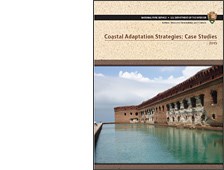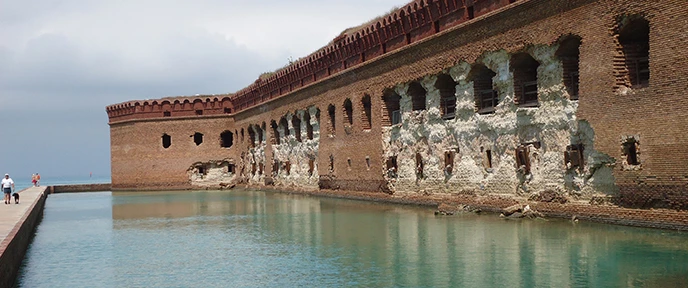The National Park Service protects resources in over 120 coastal and Great Lakes parks of significant ecological, cultural, and societal value. These parks areas are increasingly experiencing or threatened by impacts from climate change, including sea level rise and lake level fluctuations, coastal flooding and storm surge inundation, shoreline erosion, saltwater intrusion, rising groundwater tables, ocean acidification, and changing temperature and precipitation patterns.
Many coastal park units are taking proactive action to prepare for and respond to climate change. These actions range from data collection and analysis to better understand impacts to resources, incorporating anticipated future climate conditions into long-term and short-term park management strategies, relocating or designing infrastructure to be more resilient to dynamic coastal environments, documenting and protecting historic and archaeological resources, and restoring critical habitats and ecosystem services.
In 2015, the National Park Service released a summary report detailing 24 coastal adaptation efforts occurring at parks across the country. This report was compiled to generate inspiration and dialogue among park managers and other coastal management agencies responsible for stewarding natural and cultural resources amidst the hazards of climate change.
Many coastal park units are taking proactive action to prepare for and respond to climate change. These actions range from data collection and analysis to better understand impacts to resources, incorporating anticipated future climate conditions into long-term and short-term park management strategies, relocating or designing infrastructure to be more resilient to dynamic coastal environments, documenting and protecting historic and archaeological resources, and restoring critical habitats and ecosystem services.
In 2015, the National Park Service released a summary report detailing 24 coastal adaptation efforts occurring at parks across the country. This report was compiled to generate inspiration and dialogue among park managers and other coastal management agencies responsible for stewarding natural and cultural resources amidst the hazards of climate change.

National Park Service Report, NPS 99/129700
September 2015
(PDF, 2.4 MB)
Explore the Case Studies
- Acadia National Park: Rehabilitating Stream Crossings on Historic Roads
- Amistad National Recreation Area: Reservoir Water Level Change Impacts on Cultural Resources
- Assateague Island National Seashore: Incorporating Climate Change Response into a General Management Plan
- Assateague Island National Seashore: Relocating Visitor Facilities Threatened by Erosion
- Bering Land Bridge National Preserve, Cape Krusenstern National Monument: Collecting Baseline Biological and Geologic Data to Understand Coastal Change
- Bering Land Bridge National Preserve, Cape Krusenstern National Monument: Cultural Resources Inventory and Vulnerability Assessment
- Canaveral National Seashore: Shell Mound Sites Threatened by Sea Level Rise and Erosion
- Cape Cod National Seashore: Reducing Vulnerability of Coastal Visitor Facilities
- Cape Hatteras National Seashore: Relocating the Lighthouse
- Cape Lookout National Seashore: Consideration of Shackleford Banks Renourishment
- Cape Lookout National Seashore: The Need for Storm Recovery Plans
- Dry Tortugas National Park: Strategic Planning and Responsible Investments for Threatened Historic Structures
- Everglades National Park: Developing Sustainable Visitor Facilities
- Florida Fish and Wildlife Conservation Commission: Incorporating Climate Change into Florida's State Wildlife Action Plan
- Fort Pulaski National Monument: Lighthouse Stabilization Design Incorporates Sea Level Rise
- Gateway National Recreation Area: Restoring the Jamaica Bay Wetlands
- Golden Gate National Recreation Area: Developing a Multi-Agency Vision for an Urban Coastline
- Gulf Islands National Seashore: Establishing Alternative Transportation to Fort Pickens to Supplement Vulnerable Road Access
- Gulf Islands National Seashore: Large-scale Restoration of Barrier Island Systems and Cultural Resource Protection through Sediment Placement
- National Park of American Samoa: Recognizing Coral Adaptations to Environmental Stressors
- NPS Geological Resources Division: Storm Surge and Sea Level Change Data Support Planning
- Olympic National Park: Preparing for Impacts on Archeological Sites and Traditional Resources
- Point Reyes National Seashore: Restoring the Giacomini Wetlands from Agricultural Lands
- Yellowstone National Park: Eroding Shoreline Threatens Historic Peale Island Cabin
|
|

NPS Photo by Marcy Rockman
Last updated: January 8, 2025
